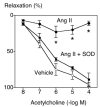Endogenous interleukin-10 inhibits angiotensin II-induced vascular dysfunction
- PMID: 19620507
- PMCID: PMC2861503
- DOI: 10.1161/HYPERTENSIONAHA.109.137158
Endogenous interleukin-10 inhibits angiotensin II-induced vascular dysfunction
Abstract
Angiotensin II (Ang II) produces inflammation and endothelial dysfunction in blood vessels. We tested the hypothesis that interleukin 10 (IL-10), an antiinflammatory cytokine, protects against Ang II-induced vascular dysfunction. Responses of carotid arteries from wild-type and IL-10-deficient mice (IL-10(-/-)) were examined in vitro after overnight incubation with vehicle or Ang II (1 nmol/L). In arteries from wild-type mice, acetylcholine (an endothelium-dependent agonist) produced relaxation that was not affected by Ang II. In contrast, relaxation to acetylcholine in arteries from IL-10(-/-) mice was reduced by >50% by Ang II (P<0.05) and this effect was prevented by a scavenger of superoxide. Vascular superoxide increased approximately 2-fold (P<0.05) after treatment with Ang II in IL-10(-/-) mice but not in wild-type. After systemic administration of Ang II (1.4 mg/kg per day for 10 days), Ang II produced modest impairment of endothelial function in wild-type mice but marked impairment in IL-10(-/-) mice (P<0.05) that was reversed by a superoxide scavenger. Increases in arterial pressure in response to Ang II were similar in wild-type and IL-10(-/-) mice. These findings provide the first evidence that endogenous IL-10 limits Ang II-mediated oxidative stress and vascular dysfunction both in vitro and in vivo suggesting that at least some of the protective effects of IL-10 may occur within the vessel wall.
Figures






References
-
- Dzau VJ. Tissue angiotensin and pathophysiology of vascular disease. A unifying hypothesis. Hypertension. 2001;37:1047–1052. - PubMed
-
- Nickenig G, Harrison DG. The AT1-type angiotensin receptor in oxidative stress and atherosclerosis. Part I: Oxidative stress and atherogenesis. Circulation. 2002;105:393–396. - PubMed
-
- Didion SP, Kinzenbaw DA, Faraci FM. Critical role for CuZnSOD in preventing angiotensin-II-induced endothelial dysfunction. Hypertension. 2005;46:1147–1153. - PubMed
-
- Savoia C, Schiffrin EL. Vascular inflammation in hypertension and diabetes: molecular mechanisms and therapeutic interventions. Clin Sci. 2007;112:375–84. - PubMed
-
- Vaziri ND, Rodriguez-Iturbe B. Mechanisms of disease: oxidative stress and inflammation in the pathogenesis of hypertension. Nature Clin Pract Nephrol. 2006;2:582–93. - PubMed
Publication types
MeSH terms
Substances
Grants and funding
LinkOut - more resources
Full Text Sources
Other Literature Sources
Miscellaneous

